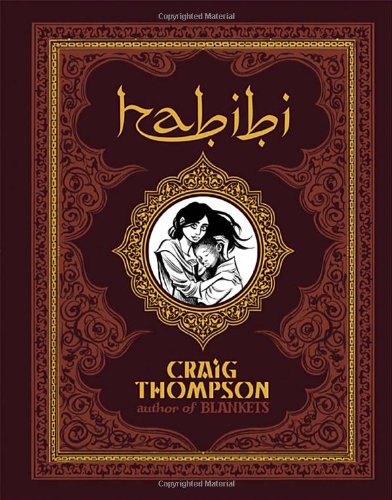Two children, Dodola and Zam, escaped from slavery and live alone for years in the desert. As they grow older, their relationship becomes strain as Dodola sees Zam as her child and Zam begins to experience sexual attraction. Dodola is captured and becomes a slave in the sultan's harem. Zam goes in search for her. Years pass, but the two never stop looking for each other.
Well. So. I heard lots of mixed things about this one. Some were saying it was the most amazing thing ever. Others disagreed and had major problems with it.
I also had problems with it. But first things first. It was beautiful. Absolutely beautiful. All of Craig Thompson's work is beautiful and I love his style of drawing and how gorgeous it can be in just black and white. So Habibi was no exception. Beautiful as always.
There were some things that bothered me a lot. In particular, I felt very uncomfortable with how Thompson drew the black eunuchs at the sultan's palace. For whatever reason, the eunuchs that watched over the sultan's harem hardly looked human. They looked like animals. Particularly, they looked like apes. Why? Why were they drawn like that? No other characters took on an animal-like appearance. I was very aware of it and it made me very uncomfortable.
So there's a lot of nakedness and a lot of sex in this book. This is fine, it's allowed to be a book that has a lot of sex in it. However, even though the book is sort of about how awful it is that women are treated like pieces of property, I thought that the female characters were incredibly over-sexualized. There was hardly a page that someone wasn't having sex or someone wasn't topless. Even if they didn't particular have a good reason to be topless, or to have their breasts showing. So it was kind of strange. On the one hand, look at how awful things can be, on the other hand, look at all the naked women! It was actually was reminding me a lot of Lost Girls in that way, which was unabashedly a pornographic book.
I was confused about the time period. At the beginning of the book, it could have been any time. It could be fairly recently, or it might have been a long time ago. I was unclear on the time period all the way though until the end, when suddenly we seem to be in the middle of a modern city and there are condos and water bottle factories. I guess it could have just regular process over the course of the character's lifetime. Or maybe we were moving through time? Because it was suppose to be timeless? Or maybe it just wasn't clear.
So I can't really say I enjoyed Habibi. I didn't. Visually it's certainly very beautiful, but the story itself didn't sit well with me. I'm not even completely clear what the point of the story was. I'd like to know how much research Craig Thompson did for this book, or if most of this was just coming out of his head. If I had to guess, I'd say most of it was coming out of his head.

No comments:
Post a Comment